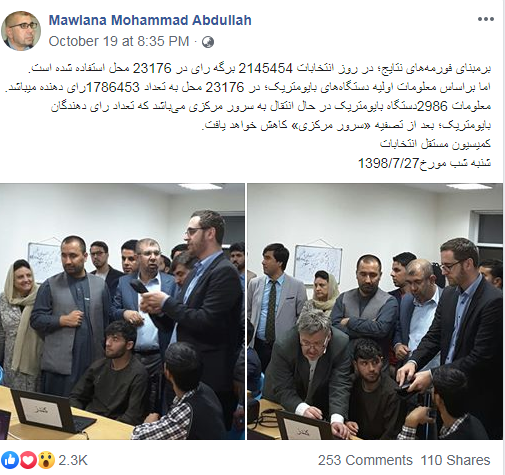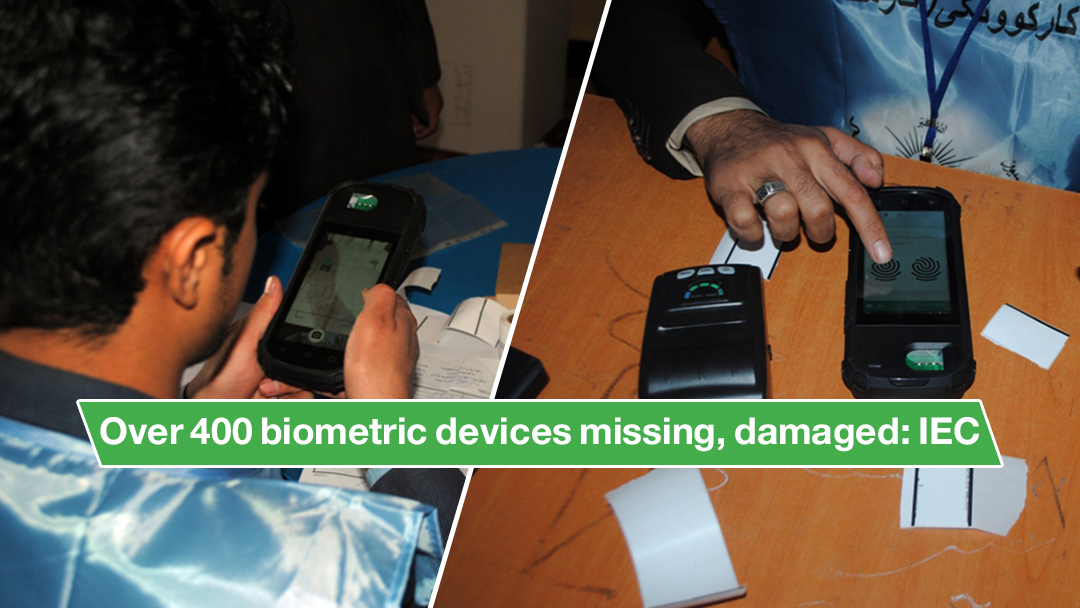Over 400 biometric devices missing, damaged: IEC
KABUL (Pajhwok): The Independent Election Commission (IEC) says that more than 400 biometric voter verification (BVV) devices are missing or broken and the issue would be dealt based on the type of cases.
The IEC officials say the devices were missing as result of Taliban attacks on polling stations and seizure of the devices by police or strongmen.
A well-known source in the Secretariat of the IEC who wished to go unnamed told Pajhwok Afghan News that 191 biometric devices were missing and around 200 others are broken and failed to work during the September 28 presidential election.
“The breaking of devices mean that they are no longer working and irreparable or unusable,” the source said, adding 172 printers and 495 SD cards of biometric devices were also missing during the electoral operation.
The official said 1,983 power banks, 2,252 chargers, 872 data cables and 236 SIM cards from the biometric devices were also lost.
The source added that some biometric devices and relevant tools were lost during workers training programs: 19 of these devices, 17 printers, 69 SD cards, 105 power banks and 220 chargers were lost in such programs in 34 provinces of the country and are yet to be recovered, he said.
Those who neglected and lost the tools would be treated according to the law, he added, saying 16 biometric devices from Kabul and one from Takhar province have yet to reach the central office.
A day earlier, IEC officials told a press conference that 34,958 biometric devices dedicated for the election and 34,767 of them have returned to the commission while 191 of them had not reached the office.
According to the IEC, of 34,767 of these devices, 23,176 of them contained voter information and the so far, voter information from 23,176 devices has been entered to the central server of the commission.
During the week of 20 October, the IEC said 2,888 other biometric devices had been quarantined because they were either broken, failed to start, had taken repeated photos of the same voter, had not photographed the results forms, or had other technical issues. The IEC resolved approximately 2,400 of these units by 23 October, when the corresponding results forms were photographed by the biometric devices, which enabled them to transit their results and biometric data to the central server in the presence of candidate agents and observers. The other devices remain under review by the IEC.
On Mawlana Abdullah, a commissioner of IEC in a Facebook post said on October 19 that voter information from 2,986 biometric devices had been transferred to the central server and the number of voters would decline after the data cross-checks and de-duplication process in the IEC’s central server.

Zabihullah Sadat, acting IEC spokesman, on Monday October 28 said the issue of quarantined biometric devices had been resolved in presence of IEC commissioners and observers and the date transferred to central server.
Zabihullah Sadat, acting IEC spokesman On October 19, said, “Such a complicated process would definitely have losses, unfortunately we had some losses during the election operation.”
Without providing the specific date, he said the collection of biometric devices had been launched and provincial IEC heads were ordered share their reports about missing devices with the central office.
Rahima Zarifi, a commissioner of IEC on October 23 said, “We seriously follow this issue and we ordered our provincial officials to urgently investigate about missing devices and SD cards and find them.”
In response to a question about the votes of missing devices, she said that the type and case of each device may vary and the issue would be responded according to the type of devices and the conclusion on the regard will be shared with the public in the next two days.
According to the IEC, biometric devices would be collected in cooperation of police forces and then handed over to the Commission’s central office.
Pajhwok Afghan News findings show that most of the devices were lost in Baghlan, Kandahar and Faryab provinces.
Ahmad Hanif Sharifi, the Independent Electoral Complaints Commission (IECC) deputy secretary for northern Baghlan province, told Pajhwok that 65 biometric sets went missing during the election operations.
He said, “61 sets are missing in Baghlan-i-Markzai district and four sets in Nehrin district but investigation had been conducted in this regard and the number might increase.”
Meanwhile, Emal, IEC head for southern Kandahar province, told Pajhwok that 26 biometric sets are also missing in Kandahar.
He said, “Such problems occurred in the unstable districts when some rockets landed at polling stations and damaged everything there.”
An IEC official in Faryab,
told Pajhwok that four biometric sets are missing in Garizwan district and
another 30 biometric sets, all sensitive materials and vote pages had been
destroyed when Qarmaqol district fallen to the Taliban militant before one
night of election day.
Nasrat Rahimi, spokesman for the Ministry of Interior affair, told Pajhwok information in this regard is yet to be collected.
Electoral teams’ reaction:
Ajmal Hodman, an official of the State Builder electoral team, told Pajhwok the biometric ballot figures which had been provided by the IEC are not acceptable for them because the real number of voters are more than that and IEC should investigate votes of missing and broken biometric sets.
According to his information, 199 biometric sets and 497 SD cards have gone missing.
He said IEC was responsible for taking care of biometric sets and should have respect for the people’ votes.
Hekmat Safi, a spokesman for the Stability and Partnership electoral team, told Pajhwok that the IEC should firstly announce its stand about the missing biometric sets.
He said, “IEC should provide information to the Afghanistan’s people that where the sets have been missing and who are the perpetrators behind the issue.”
Election oversight institutions:
Electoral monitors Free and Fair Election Foundation of Afghanistan (FEFA) head Yousuf Rashid told Pajhwok that chances should be given to the IEC to find the missing biometric sets and then make sure of its accuracy.
He said that if there is discovery of biometric sets with changes apart from the date and time on the Election Day, then any changes to the date and time in the settings should be disclosed or else there would be concern about manipulation.
Milad Yousuf Ibrahim, an observer of the electoral team at the IEC, has expressed his deep concern over the biometric sets missing, and said: “The leading electoral teams had made decision to not count votes that arrive late and are missing.”
The presidential election was held on September 28 and the IEC had intended to announce the preliminary results said on October 19 and the final results on November 7; however, the IEC has required more time to process the results and investigate suspect polling stations in the provinces in coordination with the IECC and in the presence of candidate agents and observers. The new date from the IEC for preliminary results is November14 and for final results by 6 December.

Azizullah Hamdard
Hits: 8474
Agreement reached on procedure for peace talks
KABUL (Pajhwok): An agreement between the Afghan government and the Taliban negotiating te…



